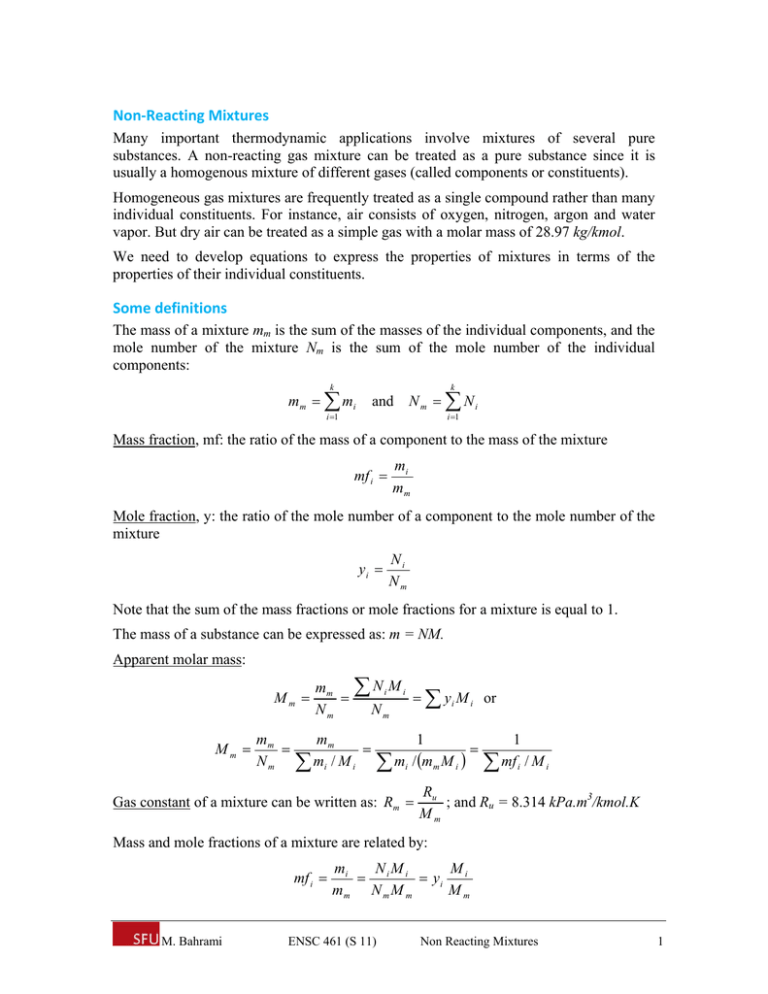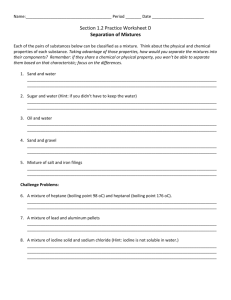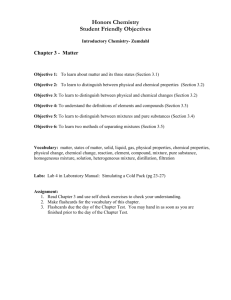Non‐Reacting Mixtures
advertisement

Non‐Reacting Mixtures Many important thermodynamic applications involve mixtures of several pure substances. A non-reacting gas mixture can be treated as a pure substance since it is usually a homogenous mixture of different gases (called components or constituents). Homogeneous gas mixtures are frequently treated as a single compound rather than many individual constituents. For instance, air consists of oxygen, nitrogen, argon and water vapor. But dry air can be treated as a simple gas with a molar mass of 28.97 kg/kmol. We need to develop equations to express the properties of mixtures in terms of the properties of their individual constituents. Some definitions The mass of a mixture mm is the sum of the masses of the individual components, and the mole number of the mixture Nm is the sum of the mole number of the individual components: k k m m mi Nm Ni and i 1 i 1 Mass fraction, mf: the ratio of the mass of a component to the mass of the mixture mi mm mf i Mole fraction, y: the ratio of the mole number of a component to the mole number of the mixture Ni Nm yi Note that the sum of the mass fractions or mole fractions for a mixture is equal to 1. The mass of a substance can be expressed as: m = NM. Apparent molar mass: Mm Mm mm Nm mm Nm N M mm mi / M i i Nm i y i M i or 1 mi / mm M i Gas constant of a mixture can be written as: Rm 1 mf i / M i Ru ; and Ru = 8.314 kPa.m3/kmol.K Mm Mass and mole fractions of a mixture are related by: mf i M. Bahrami mi NM M i i yi i mm N m M m Mm ENSC 461 (S 11) Non Reacting Mixtures 1 P‐V‐T relationships for Ideal Gas Mixtures An ideal gas is defined as a gas whose molecules are spaced so far apart so that the behavior of a molecule is not influenced by the presence of other molecules. At low pressures and high temperatures, gas mixtures can be modeled as ideal gas. The behavior of ideal gas can be expressed by simple relationship Pv = RT, or by using compressibility factor by Pv = ZRT. Prediction of the P-v-T behavior of gas mixtures is typically based on the following two models: Dalton’s law (additive pressures): the pressure of a mixture of gases is the sum of the pressures of its components when each alone occupies the volume of the mixture, V, at the temperature, T, of the mixture. Gas A Gas B Gas mixture V, T V, T V, T mA, NA, PA + mB, NB, PB = mm = mA + mB Nm = NA + NB Pm = PA + PB Fig.1: Dalton’s law of additive pressures for a mixture of two gases. Amagat’s law (additive volumes): the volume of a mixture is the sum of the volumes that each constituent gas would occupy if each were at the pressure, P, and temperature, T, of the mixture. Gas A Gas B Gas mixture P, T P, T P, T mA, NA, VA + mB, NB, VB = mm = mA + mB Nm = NA + NB Vm = VA + VB Fig.2: Amagat’s law of additive volumes for a mixture of two gases. The volume fraction is defined as the ratio Vi/Vm. Also we define the pressure fraction as the ratio of Pi/Pm k Pm Pi i 1 k and Vm Vi i 1 By combining the results of the Amagat and Dalton models, we obtain for ideal gas mixtures: M. Bahrami ENSC 461 (S 11) Non Reacting Mixtures 2 Pi Vi N i yi P V Nm Therefore, Amagat’s law and Dalton’s law are equivalent to each other if the gases and the mixture are ideal gases. This is strictly valid for ideal-gas mixtures. Real Gas Properties Dalton’s law and Amagat’s law can also be used for real gases, often with reasonable accuracy. However; the component pressure or volume should be calculated using relationships that take into account the deviation of each component from ideal gas behavior. One way of doing this is to use the compressibility factor: PV = ZNRuT The compressibility factor of the mixture Zm can be calculated from: k Z m yi Z i i 1 where Zi is determined either at Tm and Vm (Dalton’s law) or at Tm and Pm (Amagat’s law) for each individual gas. It should be noted that for real-gas mixtures, these two laws give different results. Kay’s Rule Involves the use of a pseudo-critical pressure and pseudo-critical temperature for the mixture, defined in terms of the critical pressures and temperatures of the mixtures components as: P ' cr ,m y i Pcr ,i and T ' cr ,m y i Tcr ,i The compressibility factor of the mixture is then easily determined by using these pseudo-critical properties. The result obtained by using Kay’s rule is accurate to within 10%. Example 1 A rigid tank contains 2 kmol of N2 and 6 kmol of CO2 gases at 300 K and 15 MPa. Estimate the volume of the tank on the basis of: a) the ideal-gas equation of state, b) Kay’s rule, c) compressibility factors and Amagat’s law, and d) compressibility factors and Dalton’s law. Analysis: a) Assuming ideal gas, the volume of the mixture is calculated from: N m Ru Tm 8kmol 8.314kPa.m 3 / kmol. K 300 K Vm 1.330m 3 15,000kPa Pm since N m N N 2 N CO2 6 2 8kmol The molar fractions are: M. Bahrami ENSC 461 (S 11) Non Reacting Mixtures 3 y N2 NN2 Nm 2kmol 0.25 and 8kmol y CO2 N CO 2 Nm 6kmol 0.75 8kmol b) Kay’s rule; critical temperatures and pressures of N2 and CO2 can be found from Table A-1. Tcr' ,m y i Tcr ,m y N 2 Tcr , N 2 y CO2 Tcr ,CO2 0.25 126.2 K 0.75 304.2 K 259.7 K Pcr' ,m y i Pcr ,m y N 2 Pcr , N 2 y CO2 Pcr ,CO2 0.25 3.39MPa 0.75 7.39 MPa 6.39MPa then; Tm 300 K 1.16 ' Tcr ,m 259.7 K Fig . A 15b Z m 0.49 Pm 15MPa PR ' 2.35 Pcr ,m 6.39MPa TR thus; Z m N m Ru Tm 0.498kmol 8.314kPa.m 3 / kmol. K 300 K Vm 0.652m 3 Pm 15,000kPa c) Amagat’s law: Tm 300 K 2.38 Tcr , N 2 126.2 K Fig . A 15b Z N 2 1.02 Pm 15MPa 4.42 Pcr , N 2 3.39MPa TR , N 2 N2 : PR , N 2 300 K 0.99 Tcr ,CO2 304.2 K Fig . A 15b Z CO2 0.3 Pm 15MPa 2.03 Pcr ,CO2 7.39MPa TR ,CO2 CO2 : PR ,CO2 Tm Mixture: Z m y i Z i y N 2 Z N 2 y CO2 Z CO2 0.251.02 0.750.3 0.48 Thus; Vm Z m N m Ru Tm 0.488kmol 8.314kPa.m 3 / kmol. K 300 K 0.638m 3 Pm 15,000kPa Note that the compressibility factor in this case turned out to be almost the same as the one determined by using Kay’s rule. M. Bahrami ENSC 461 (S 11) Non Reacting Mixtures 4 d) Dalton’s law This time the compressibility factor of each component is to be determined at the mixture temperature and volume, which is not known. Therefore, an iterative solution is required. We start the calculations by assuming that the volume of the gas mixture is 1.330 m3, the value determined by assuming ideal-gas behavior. The TR values are identical to those obtained in part c). VR, N 2 VN2 Ru Tcr , N 2 / Pcr , N 2 Vm / N N 2 Ru Tcr , N 2 / Pcr , N 2 1.33m /2kmol 8.314kPa.m / kmol.K 126.2K /3390kPa 2.15 3 3 Similarly, 1.33m /6kmol 8.314kPa.m / kmol.K 304.2K /7390kPa 0.648 3 V R ,CO2 3 From Fig. A-15, we read ZN2 = 0.99 and ZCO2 = 0.56, thus, Z m y N 2 Z N 2 y CO2 Z CO2 0.250.99 0.750.56 0.67 and, Vm Z m N m Ru Tm 0.67 8kmol 8.314kPa.m 3 / kmol. K 300 K 0.891m 3 Pm 15,000kPa This is 33% lower than the assumed value. Therefore, we should repeat the calculations, using the new value of Vm. When calculations are repeated we obtain 0.738 m3 after the second iteration, 0.678 m3 after the third iteration, and 0.648 m3 after the fourth iteration. This value does not change with more iteration. Therefore: Vm = 0.648 m3 Note that the results obtained in parts (b), (c), and (d) are very close. But they are very different from the ideal gas value. Therefore, treating a mixture of gases as an ideal gas may yield unacceptable errors at high pressures. Mixture Properties Extensive properties such as U, H, cp, cv and S can be found by adding the contribution of each component at the condition at which the component exists in the mixture. k k k i 1 i 1 i 1 k k k i 1 i 1 i 1 U m U i mi u i N i u i H m H i mi hi N i hi k k k i 1 i 1 i 1 S m S i mi s i N i s i M. Bahrami ENSC 461 (S 11) kJ kJ kJ / K Non Reacting Mixtures 5 where u is the specific internal energy of the mixture per mole of the mixture. Also; k k i 1 i 1 k k i 1 i 1 u m mf i u i kJ / kg and u m y i u i kJ / kmol kJ / kmol hm mf i hi kJ / kg and hm y i hi k k i 1 i 1 s m mf i si kJ / kg and s m y i si kJ / kmol k k i 1 i 1 kJ / kmol.K cv ,m mf i cv ,i kJ / kg.K and cv ,m y i cv ,i k k i 1 i 1 kJ / kmol.K c p ,m mf i c p ,i kJ / kg.K and c p ,m y i c p ,i Changes in internal energy and enthalpy of mixtures: k k k i 1 i 1 i 1 k k k i 1 i 1 i 1 kJ U m U i mi u i N i u i kJ H m H i mi hi N i hi k k k i 1 i 1 i 1 S m S i mi si N i si kJ / K Care should be exercised in evaluating the Δs of the components since the entropy of an ideal gas depends on the pressure or volume of the component as well as on its temperature. k k i 1 i 1 s 2 s1 m mf i s 2 s1 i mf i c p ,i ln T2 T Ri ln 1 Pi , 2 Pi ,1 i This relationship can also be expressed on a per mole basis. Notes: when ideal gases are mixed, a change in entropy occurs as a result of the increase in disorder in the systems if the initial temperature of all constituents are the same, the mixing process is adiabatic; i.e., temperature does not change – but entropy does! P P S m m1 R1 ln 1 m2 R2 ln 2 ... P P k P mi Ri i P i 1 M. Bahrami ENSC 461 (S 11) Non Reacting Mixtures 6





